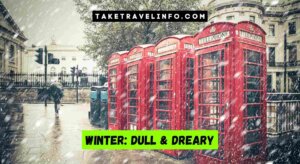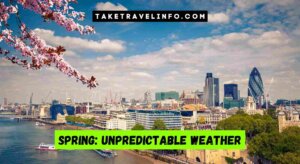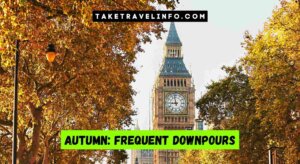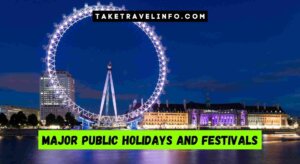The worst time to visit London is during the winter months due to cold and rainy weather. London can be a captivating city to explore with its rich history, iconic landmarks, and vibrant culture.
However, choosing the right time to visit is crucial for a memorable experience. If you’re planning a trip to London, it’s important to consider the weather and crowd levels. While London is enjoyable year-round, the winter months, from December to February, can be the least favorable time to visit.
The city experiences cold and rainy weather during this period, making outdoor activities less enjoyable. Additionally, the limited daylight hours can shorten your sightseeing opportunities. To make the most of your trip, consider visiting London during the more pleasant spring or summer months when the weather is milder and the city is buzzing with festivals and events.
Winter: Dull & Dreary

London can be a vibrant and bustling city throughout the year, but there are certain times when visiting may not be ideal for everyone. One such time is during the winter months when the city can become dull and dreary.
The cold and gloomy weather, limited daylight hours, and reduced outdoor activities make it one of the worst times to experience the charm of London to its fullest.
Cold And Gloomy Weather:
- London’s winter weather can be quite harsh, with temperatures dropping to freezing levels.
- Cold winds and frequent rain showers make outdoor exploration uncomfortable and can dampen the mood of visitors.
- The cityscape loses some of its vibrancy, as gray skies prevail, and gloomy weather becomes the norm.
Limited Daylight Hours:
- Winter days in London are shorter, with daylight lasting for only a few hours.
- Limited daylight can restrict the time available for sightseeing and enjoying outdoor attractions.
- It can be challenging to plan activities effectively due to the shorter daylight hours.
Reduced Outdoor Activities:
- London is known for its multitude of outdoor events and activities, but many of these are significantly reduced or even suspended during the winter months.
- Iconic parks and gardens become less inviting as they lose their lush greenery, and outdoor markets are not as bustling.
- The charm of outdoor exploration is somewhat lost during this season.
Although London may have its charms all year round, the winter season may not be the best time to experience them. The dull and dreary weather, limited daylight hours, and reduced outdoor activities can make it less appealing for visitors seeking to immerse themselves in the vibrancy and energy that London has to offer.
Spring: Unpredictable Weather

London is a vibrant city, with its fair share of wonderful experiences to offer. However, depending on the time of year, there are certain drawbacks to consider. Spring, in particular, can be quite unpredictable when it comes to the weather.
So, if you’re planning to visit London during this season, here are a few key points to keep in mind:
Frequent Rain Showers:
- London is notorious for its rain showers, and spring is no exception. So, be sure to pack an umbrella or a waterproof jacket to stay dry during your explorations.
- Rain showers can come and go quickly, so keeping an eye on the weather forecast and planning accordingly will help you make the most of your time in the city.
Temperature Fluctuations:
- Spring in London can bring about significant temperature fluctuations. While some days can be pleasantly mild, others can be chilly. Layering your clothing is a wise choice to stay comfortable throughout the day.
- It’s also a good idea to pack a lightweight jacket or a sweater, as evenings can get colder, particularly when the rain showers occur.
Crowded Tourist Attractions:
- London is a popular tourist destination all year round, and spring is no exception. As the weather becomes more pleasant, the city tends to attract more visitors, resulting in crowded attractions.
- It’s advisable to plan your visits to popular landmarks and attractions early in the day or during weekdays to avoid long queues and overcrowded spaces.
With these considerations in mind, spring can still be a delightful time to explore London. Just make sure to be prepared for the unpredictable weather, dress in layers, and plan your itinerary wisely to make the most of your visit!
Summer: Crowded And Expensive

High Volume Of Tourists
London in the summer attracts a high volume of tourists from all over the world. The city becomes bustling with visitors eager to explore its iconic landmarks and experience its vibrant atmosphere. However, with such a large influx of tourists, it can become overcrowded and challenging to navigate through the streets and attractions.
- Increased foot traffic can lead to longer wait times and queues at popular tourist spots.
- The city’s transportation systems, including buses and the underground, can become crowded during peak travel times, making it less comfortable to get around.
Longer Queues And Wait Times
During the summer months, the queues and wait times at popular attractions can be significantly longer than usual. This means that visitors may have to wait for extended periods before gaining entry to attractions and landmarks. Some key points to note about this:
- Popular attractions such as the Tower of London, Buckingham Palace, and the British Museum can have particularly long queues.
- Waiting in line for extended periods can be tiresome, especially during hot summer days. Visitors may need to plan their day accordingly and be prepared for the wait.
Price Hikes For Accommodation And Attractions
Summer is the peak tourist season in London, which also means higher demand for accommodation and attractions. As a result, prices tend to rise during this time, making it more expensive for visitors. Here are some key points to consider:
- Accommodation costs can be significantly higher, especially in central areas of the city. It is advisable to book well in advance to secure more affordable options.
- Popular attractions often increase their ticket prices during peak season, which can impact travelers’ budgets.
- Dining out and other everyday expenses may also be more expensive due to increased demand.
Visiting London during the summer months can be filled with excitement and vibrant energy. However, it’s important to be prepared for the high volume of tourists, longer queues and wait times, as well as the increase in prices for accommodation and attractions.
With proper planning and realistic expectations, a summer trip to London can still be a memorable experience.
Autumn: Frequent Downpours

Autumn in London can be a challenging time to plan a visit, as the frequent downpours make it one of the worst seasons in terms of weather conditions. However, don’t let that discourage you from exploring all that this vibrant city has to offer.
Despite the rainy and damp weather, there are still plenty of activities to enjoy indoors and outdoors. So, let’s dive into the key points to consider when visiting London during the autumn season.
Rainy And Damp Weather:
- The autumn season in London is notorious for its wet weather, with frequent showers and drizzles throughout the day.
- The average rainfall during this time is significantly higher than in other seasons, so be sure to pack an umbrella or raincoat to stay dry.
- Expect muddy streets and damp paths, so comfortable footwear that can handle wet conditions is a must.
More Indoor Activities Required:
- With unpredictable weather, it’s essential to plan for indoor activities to make the most of your visit.
- London boasts a plethora of world-renowned museums, art galleries, and historical landmarks that provide shelter from the rain.
- Spend a day exploring the British Museum, the Tate Modern, or the national gallery to immerse yourself in art and cultural experiences.
Uncertain Weather Conditions:
- British weather is famously unpredictable, and autumn is no exception. One moment you could be enjoying clear skies, and the next, a heavy downpour.
- It’s always a good idea to check the weather forecast before heading out and be prepared for sudden changes.
- Flexibility is key during this season, so have a backup plan and be ready to adapt your itinerary accordingly.
London might experience frequent downpours during the autumn season, but that shouldn’t deter you from exploring this incredible city. Just remember to dress appropriately, plan indoor activities, and embrace the unpredictable weather. With a versatile itinerary and a positive attitude, you’ll still be able to make the most of your visit to London, rain or shine.
Major Public Holidays And Festivals

London is a vibrant city that attracts millions of visitors each year, but there are certain times when it’s best to avoid the hustle and bustle. Major public holidays and festivals can make London overcrowded and expensive, making it difficult to fully enjoy your visit.
Here are some key points to keep in mind:
Overcrowded Attractions And Events:
- During major public holidays and festivals, popular attractions such as Buckingham Palace, the Tower of London, and the British Museum can become incredibly crowded. Long queues and limited space can make it challenging to fully appreciate these landmarks.
- Festivals like notting hill carnival and new year’s Eve celebrations draw in huge crowds, leading to crowded streets and transport networks. This can affect the overall experience and make it harder to get around the city.
Difficulty Finding Accommodation:
- Major public holidays and festivals in London attract tourists from all over the world, resulting in high demand for accommodation. This can make it difficult to find affordable and conveniently located places to stay.
- Hotels, hostels, and vacation rentals often have limited availability during peak times. It’s advisable to book your accommodation well in advance to secure the best options and avoid disappointment.
Increased Prices For Services And Transportation:
- With the influx of visitors during major public holidays and festivals, prices for services and transportation tend to rise. Hotels, restaurants, and even public transportation providers often increase their rates during these periods.
- Food and drink establishments in popular tourist areas may also charge premium prices, taking advantage of the increased footfall. It’s important to budget accordingly and be prepared for higher costs during these times.
Navigating London during major public holidays and festivals can pose some challenges, from overcrowded attractions and events to difficulty finding accommodation and increased prices for services and transportation. While it’s still possible to have a memorable experience, planning and being aware of these potential pitfalls can help ensure a smoother visit.
Frequently Asked Questions For Worst Time To Visit London
When Is The Worst Time To Visit London In Terms Of Weather?
The worst time to visit London in terms of weather is usually between November and February when it is cold, damp, and often rainy. The city experiences shorter daylight hours and temperatures can drop below freezing.
Are There Any Specific Months To Avoid Due To Tourist Crowds?
If you want to avoid large tourist crowds in London, it’s best to avoid the peak travel months of June, July, and August. These months tend to be busy with tourists from all over the world, therefore visiting during shoulder seasons like April-May or September-October might be more pleasant.
What Are The Busiest Times In London And Should They Be Avoided?
The busiest times in London are during major events like Wimbledon, the notting hill carnival, and the Christmas season. If you prefer a more relaxed visit with fewer crowds and shorter queues, it’s advisable to avoid these peak periods and plan your trip accordingly.
Is There A Particular Time When Accommodation Prices Are Higher?
Accommodation prices in London tend to be higher during the summer months, especially in June, July, and August, due to the influx of tourists. Prices may also increase during major events and holidays such as new year’s Eve. Booking in advance or visiting during the shoulder seasons can help you save money on accommodation.
Are There Any Specific Times When Attractions Are Closed Or Have Limited Hours?
While most attractions in London are open year-round, it’s worth noting that some may have limited hours or be closed on certain public holidays such as Christmas Day, new year’s Day, and Easter Sunday. It’s recommended to check the opening times of specific attractions before visiting to avoid disappointment.
What Is The Worst Time To Visit London For Budget Travelers?
The worst time for budget travelers to visit London is during the peak summer months and major events, as prices for flights, accommodation, and attractions are usually higher. If you’re looking to save money, consider visiting during the off-peak shoulder seasons or taking advantage of discounted rates during the winter months.
Conclusion
To wrap up, certain seasons can make visiting London less ideal. The winter months, characterized by cold temperatures and limited daylight, may hinder outdoor activities and sightseeing. Additionally, the summer months, despite being popular among tourists, can be crowded and expensive.
It is crucial to consider these factors when planning a visit to London to ensure a more enjoyable and hassle-free experience. However, London is a city that offers something for everyone throughout the year. Spring and autumn bring pleasant weather and fewer crowds, making them favorable times to explore the city’s attractions.
Ultimately, the best time to visit London depends on personal preferences and priorities. By carefully considering the weather, crowd levels, and budget, travelers can optimize their experience and make the most of their time in this vibrant and diverse metropolis.


1 thought on “Worst Time to Visit London”